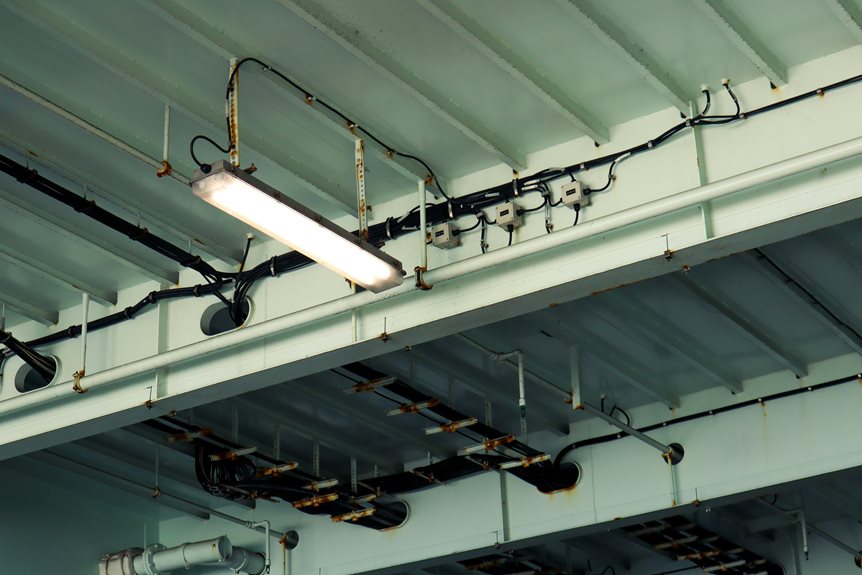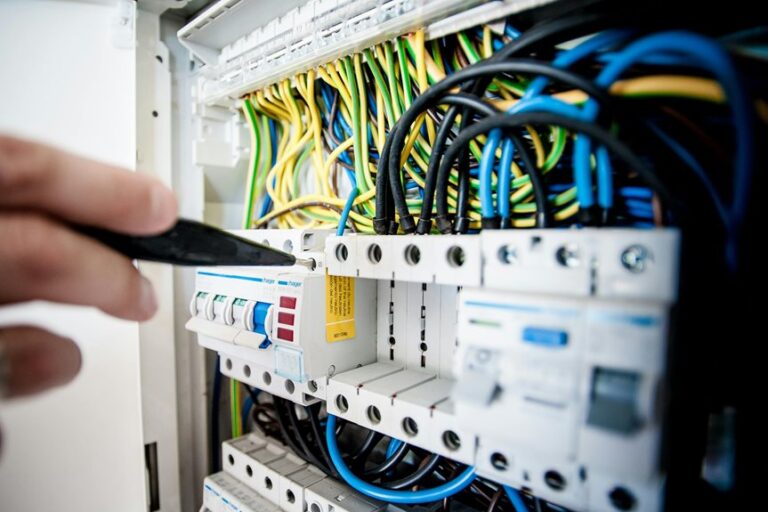You might think warehouse electrical systems are just a minor detail, but they're foundational to operational efficiency. These systems not only power essential functions like lighting and machinery but also greatly impact safety and productivity. Understanding the key components and maintenance practices is critical for optimizing performance and ensuring compliance with safety standards. As you consider these aspects, you'll discover the complex interplay between energy efficiency and advanced technologies, which raises questions about how to future-proof your warehouse operations.
Importance of Electrical Systems
Electrical systems are the backbone of warehouse operations, powering everything from lighting to automated machinery. Without a reliable electrical system, your warehouse would face significant operational disruptions. You rely on these systems for consistent energy supply, which directly impacts productivity and safety. Properly functioning electrical systems guarantee that lighting is adequate for all areas, reducing the risk of accidents and enhancing employee efficiency.
In a modern warehouse, automated machinery requires precise electrical input for seamless operation. This technology increases throughput and reduces labor costs, making your operations more competitive. Additionally, electrical systems play an essential role in climate control, maintaining ideal conditions for inventory storage, particularly for temperature-sensitive goods.
You also need to take into account the scalability of your electrical systems. As your warehouse expands or evolves, your electrical infrastructure must adapt to increased load demands. Regular maintenance and strategic upgrades are vital for preventing failures that could halt your operations.
Fundamentally, strong electrical systems aren't just a necessity; they're a strategic asset that influences your warehouse's overall performance, safety, and adaptability in an ever-changing market.
Key Components of Electrical Systems
A well-functioning warehouse relies on several key components that make up its electrical systems. First, the main electrical service entrance delivers power from the utility grid to your facility. This includes transformers that reduce voltage levels to usable levels.
Next, the distribution panel plays a critical role by directing power to various circuits throughout the warehouse. Circuit breakers protect these circuits from overloads, guaranteeing safety and reliability.
Additionally, you'll find wiring systems designed to handle the electrical load efficiently, minimizing energy loss.
Lighting systems are integral, providing sufficient illumination for safety and productivity. You may opt for LED fixtures, which offer longevity and low energy consumption.
Don't overlook emergency lighting, as it's essential for safe evacuation during power failures.
Lastly, consider the role of backup power systems, such as generators or uninterruptible power supplies (UPS). These components guarantee operations continue seamlessly during outages.
Energy Efficiency Strategies
Implementing LED lighting is a critical step in enhancing your warehouse's energy efficiency, considerably reducing energy consumption compared to traditional lighting.
Additionally, incorporating smart energy management systems allows you to monitor and optimize energy use in real time, maximizing savings.
Together, these strategies not only cut costs but also contribute to a more sustainable operation.
LED Lighting Implementation
Many warehouses are turning to LED lighting as a key strategy to enhance energy efficiency and reduce operational costs. By replacing traditional lighting systems with LED technology, you can greatly lower energy consumption and maintenance expenses. LEDs offer a longer lifespan and higher brightness levels, which translates to reduced replacement frequency and improved visibility in work areas.
Here's a comparison of the key benefits of implementing LED lighting:
| Feature | Traditional Lighting | LED Lighting |
|---|---|---|
| Lifespan | ~1,000 hours | ~25,000-50,000 hours |
| Energy Consumption | High | Low |
| Maintenance Frequency | High | Low |
| Heat Emission | High | Minimal |
| Initial Cost | Moderate | Higher, but savings over time |
Transitioning to LED lighting not only enhances the work environment but also supports sustainability goals. Consider conducting a lighting audit to determine the most effective LED solutions for your warehouse. By doing so, you'll maximize energy savings and improve overall operational efficiency.
Smart Energy Management
Harnessing advanced technology, smart energy management systems provide warehouses with innovative strategies to optimize energy usage and enhance operational efficiency.
By integrating IoT devices, you can monitor real-time energy consumption, identifying patterns and anomalies that indicate inefficiencies. This data-driven approach allows for targeted interventions, such as adjusting HVAC settings based on occupancy levels or implementing automated lighting controls.
Utilizing predictive analytics, these systems can forecast energy demand, enabling you to make informed decisions about energy procurement and usage. You'll find that implementing demand response strategies not only reduces costs but also enhances your facility's sustainability profile.
Additionally, integrating renewable energy sources—like solar panels—into your energy management system can further reduce reliance on grid power.
Smart energy management also facilitates energy storage solutions, allowing you to store excess energy for peak demand periods.
Ultimately, by adopting these energy efficiency strategies, you're not just optimizing operational costs; you're positioning your warehouse for long-term sustainability and resilience in an increasingly energy-conscious marketplace.
Embracing smart energy management is essential for maintaining a competitive edge in today's logistics landscape.
Safety Standards and Compliance
Understanding the regulatory framework is essential for ensuring your warehouse's electrical systems meet safety standards.
You'll need to implement best practices that align with these regulations to minimize risks and enhance operational efficiency.
Compliance not only protects your workforce but also helps avoid costly penalties.
Regulatory Framework Overview
In recent years, the regulatory framework governing warehouse electrical systems has evolved to address emerging safety concerns and technological advancements. You need to stay informed about key regulations, such as the National Electrical Code (NEC), which outlines essential safety standards for electrical installations.
Compliance with these standards is non-negotiable, as violations can lead to severe penalties and increased liability.
Additionally, the Occupational Safety and Health Administration (OSHA) mandates specific safety practices related to electrical work. You'll want to confirm that your electrical systems not only meet NEC guidelines but also adhere to OSHA regulations to mitigate risks associated with electrical hazards.
Regular inspections and maintenance are vital for compliance. You should establish protocols for routine checks, assuring all electrical equipment functions safely and efficiently.
Moreover, consider local regulations that may impose additional requirements, as these can vary considerably by jurisdiction.
Best Practices Implementation
To maintain compliance with the regulatory framework outlined previously, implementing best practices for warehouse electrical systems is essential. You need to focus on safety standards and compliance measures that not only protect your employees but also safeguard your assets. Regular inspections, proper labeling, and maintenance of electrical equipment are critical to guaranteeing a safe working environment.
Consider the following table that highlights the importance of best practices in your warehouse:
| Best Practice | Impact on Safety | Compliance Level |
|---|---|---|
| Regular Maintenance | Reduces risk of electrical fires | High |
| Proper Training | Prevents accidents | High |
| Use of Quality Materials | Enhances system reliability | Medium |
| Emergency Protocols | Guarantees quick response | High |
| Regular Inspections | Identifies potential hazards | High |
Maintenance Best Practices
Effective maintenance of warehouse electrical systems is crucial for guaranteeing operational efficiency and safety. To achieve this, you should establish a routine inspection schedule. Regularly check for signs of wear, overheating, or corrosion in wiring and connections. Use infrared thermography to identify hotspots that could indicate potential failures before they happen.
Next, confirm that all electrical components comply with local codes and standards. This compliance not only enhances safety but also streamlines maintenance processes. Consider implementing a predictive maintenance strategy that leverages data analytics to forecast potential issues, allowing for proactive repairs.
Additionally, train your staff in electrical safety protocols and proper equipment handling. This training minimizes accidents and enhances the longevity of your systems.
It's also crucial to maintain clear documentation of all maintenance activities. This record-keeping enables you to track performance trends and assess the effectiveness of your maintenance practices.
Lastly, confirm that your maintenance team has access to the right tools and resources for efficient repairs. Prioritizing these best practices will keep your warehouse electrical systems running smoothly, ultimately driving productivity and safeguarding your operations.
Smart Technology Integration
Leveraging smart technology in warehouse electrical systems can greatly enhance operational efficiency and safety. By integrating advanced sensors, IoT devices, and automated controls, you can monitor energy consumption in real-time, allowing for immediate adjustments and optimizations. This not only reduces energy waste but also lowers operational costs.
Implementing smart lighting systems equipped with motion sensors can further contribute to efficiency. These systems automatically adjust based on occupancy, ensuring that lights are only on when needed, which extends bulb life and decreases energy usage.
Moreover, smart technology facilitates predictive maintenance. By utilizing data analytics, you can identify potential electrical system failures before they occur, minimizing downtime and costly repairs.
Additionally, integrating warehouse management systems with your electrical infrastructure enables better coordination of machinery and equipment. This leads to improved workflow and reduced bottlenecks.
Incorporating smart technology also enhances safety measures. For instance, smart monitoring systems can detect electrical faults and alert personnel immediately, reducing the risk of accidents.
Common Challenges and Solutions
While smart technology integration offers numerous benefits for warehouse electrical systems, it also brings a set of common challenges that need addressing. One significant challenge is the complexity of integrating various systems, such as lighting, HVAC, and security. You'll need to guarantee these systems communicate effectively to avoid inefficiencies. Poor interoperability can lead to increased energy consumption and operational disruptions.
Another common issue is the need for ongoing maintenance and updates. Smart systems require regular software updates and hardware checks to function at their best. Neglecting this can result in system failures or vulnerabilities, impacting productivity.
Additionally, you might encounter resistance from staff who are accustomed to traditional systems. Training and change management are essential to guarantee team members are comfortable with new technologies.
Finally, cybersecurity risks are a pressing concern in smart warehouses. You must implement robust security measures, including firewalls and encryption, to protect sensitive data from potential breaches.
Future Trends in Warehouse Electrical Systems
Anticipating the future of warehouse electrical systems reveals a shift toward enhanced automation and energy efficiency. You'll notice that advanced technologies are being integrated into electrical systems, allowing for real-time monitoring and management of energy consumption. This not only reduces costs but also minimizes environmental impact.
As you explore these trends, consider the following key innovations shaping the future:
| Trend | Description | Benefits |
|---|---|---|
| Smart Sensors | Devices that monitor energy use and optimize performance. | Increased efficiency and reduced waste. |
| IoT Integration | Connecting electrical systems to the Internet for real-time data access. | Improved decision-making and predictive maintenance. |
| Renewable Energy Sources | Incorporating solar panels and wind turbines into warehouse infrastructure. | Sustainable energy supply and cost savings. |
These advancements will enable you to manage your warehouse operations more effectively, driving productivity while adhering to sustainability goals. By embracing these innovations, you'll position your operations at the forefront of the industry, ensuring a competitive edge in an evolving marketplace.
Conclusion
In conclusion, optimizing your warehouse electrical systems is essential for maximizing efficiency and safety. Did you know that well-maintained electrical systems can reduce energy costs by up to 30%? By focusing on key components, implementing energy efficiency strategies, and adhering to safety standards, you can enhance operational performance. Embracing smart technology and tackling common challenges will not only future-proof your infrastructure but also support sustainable practices, ultimately driving your business's success.








